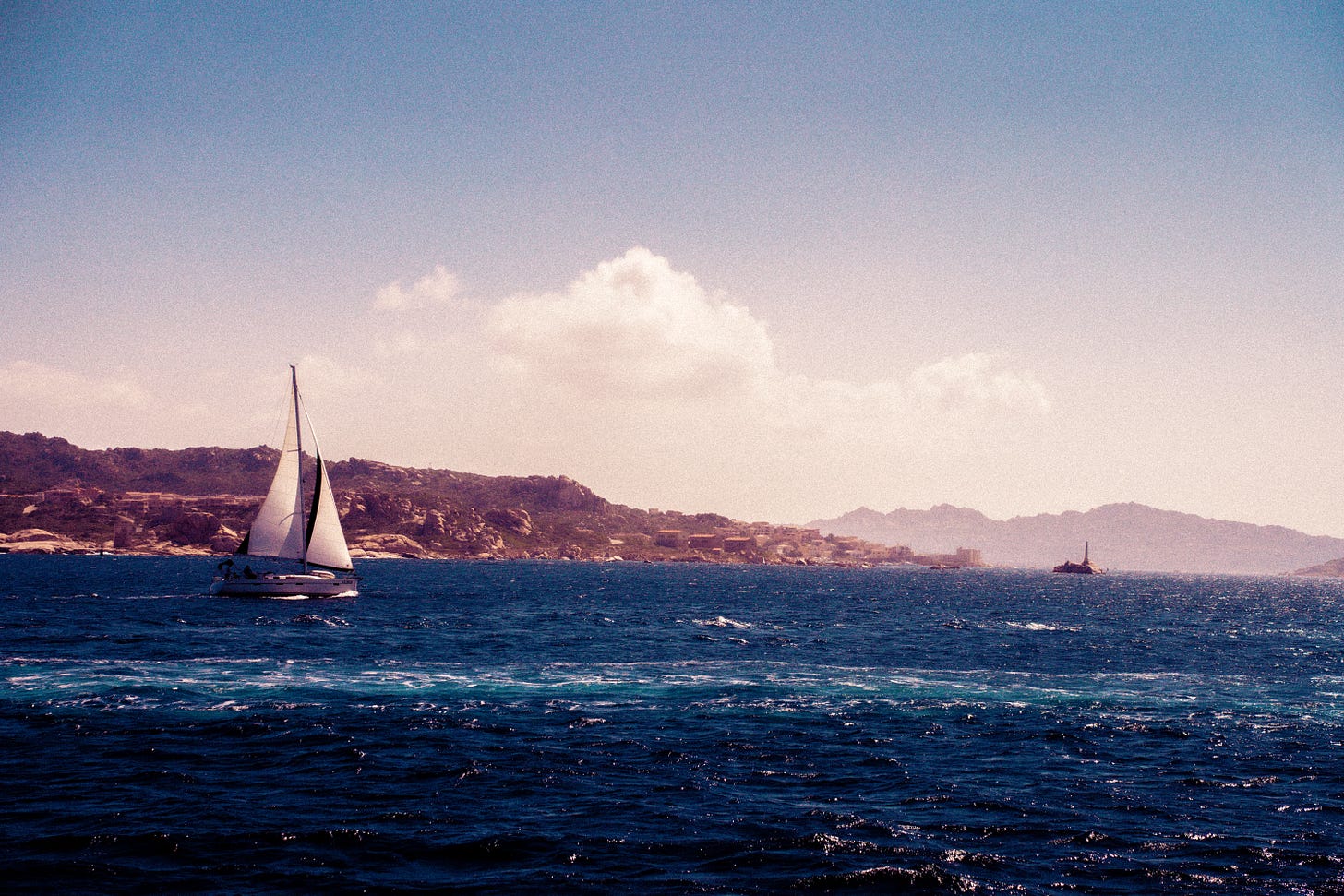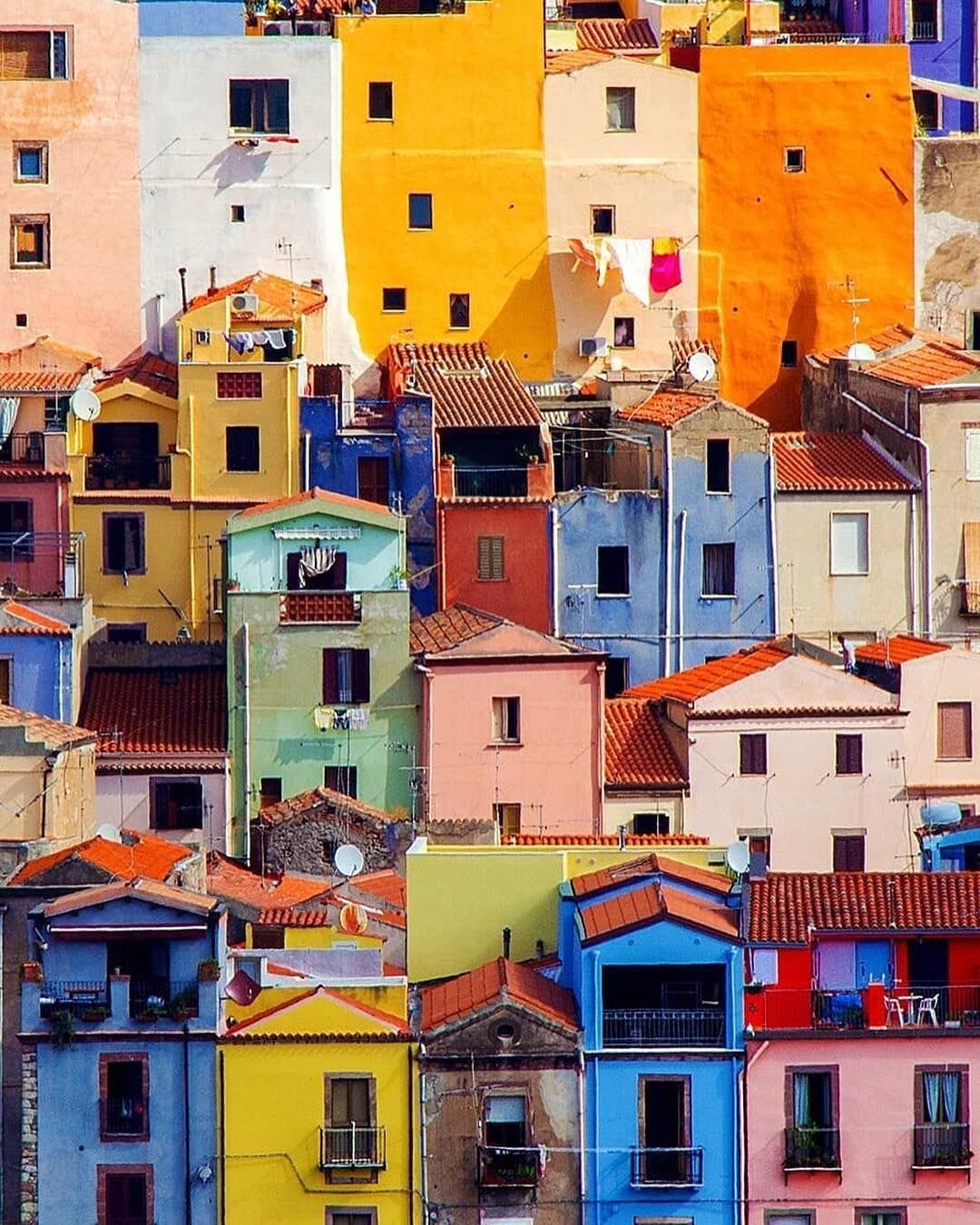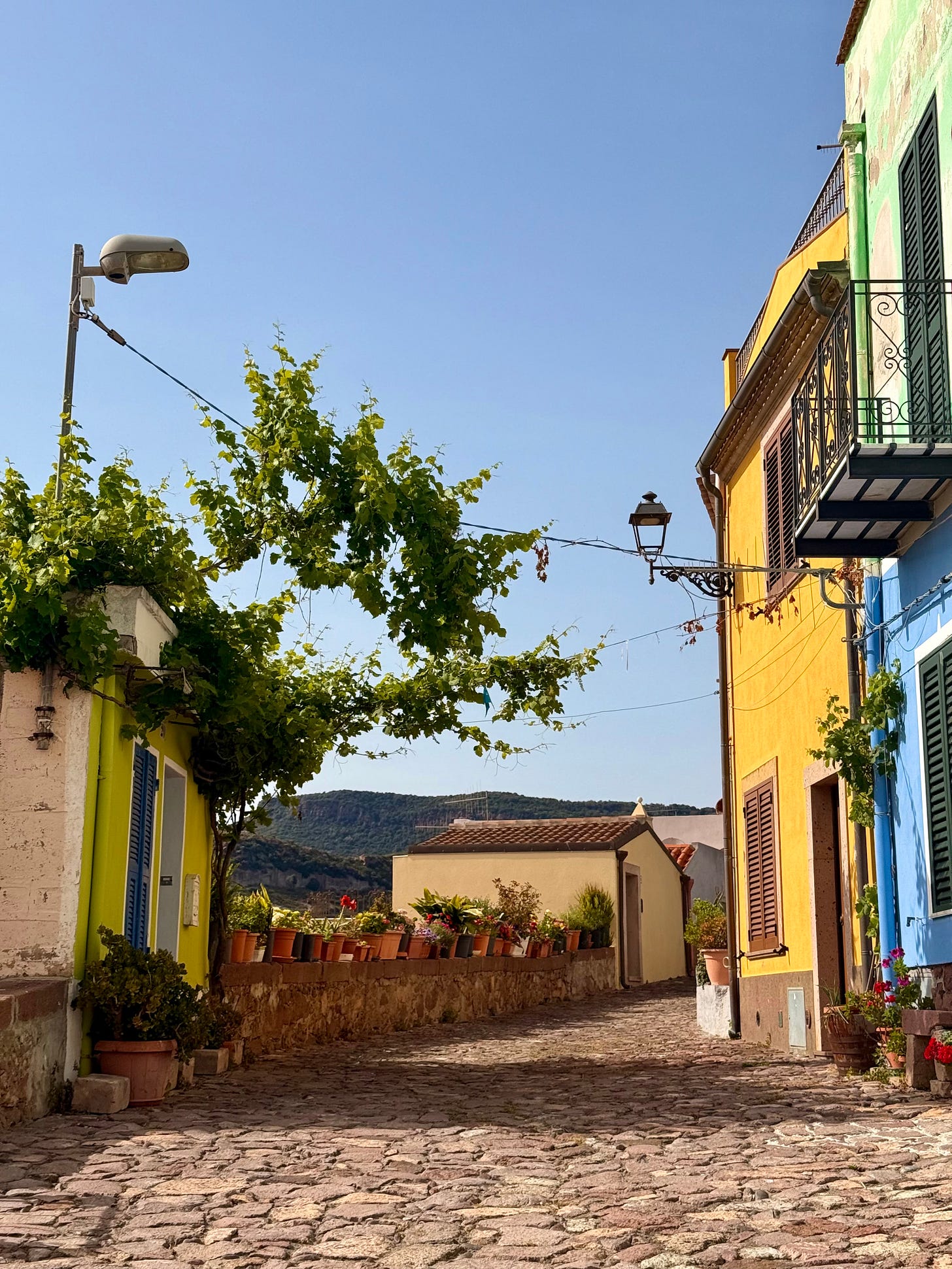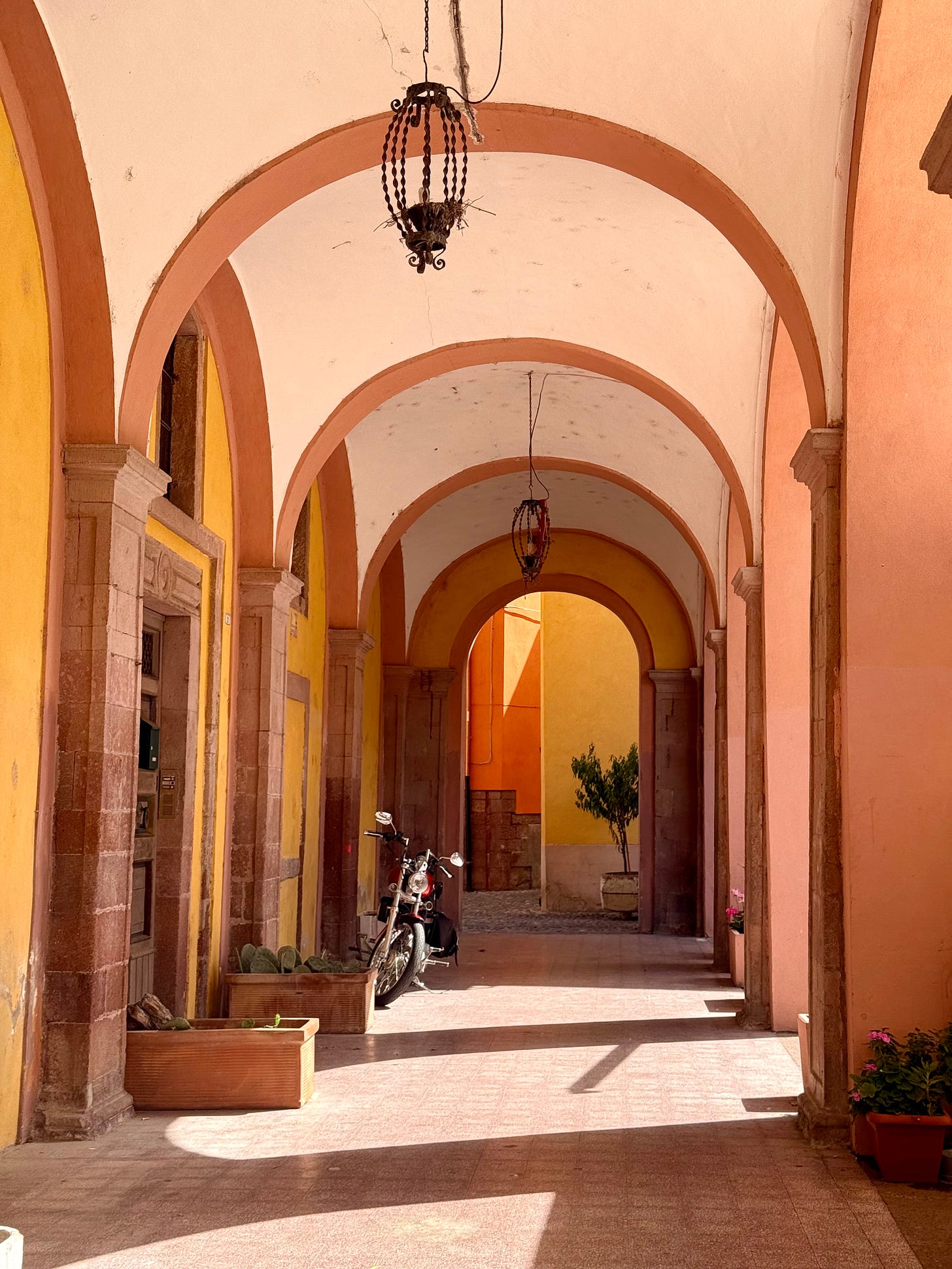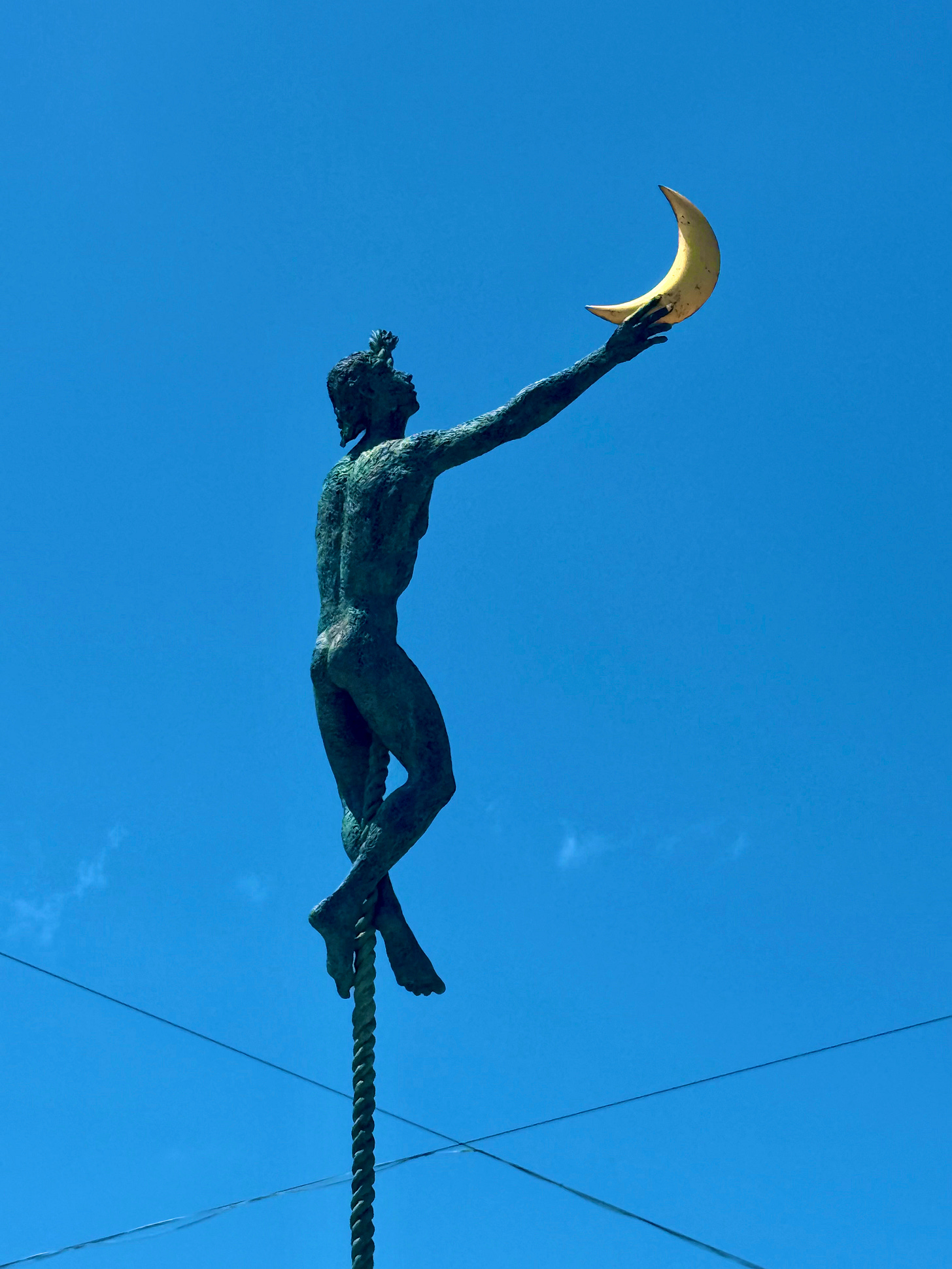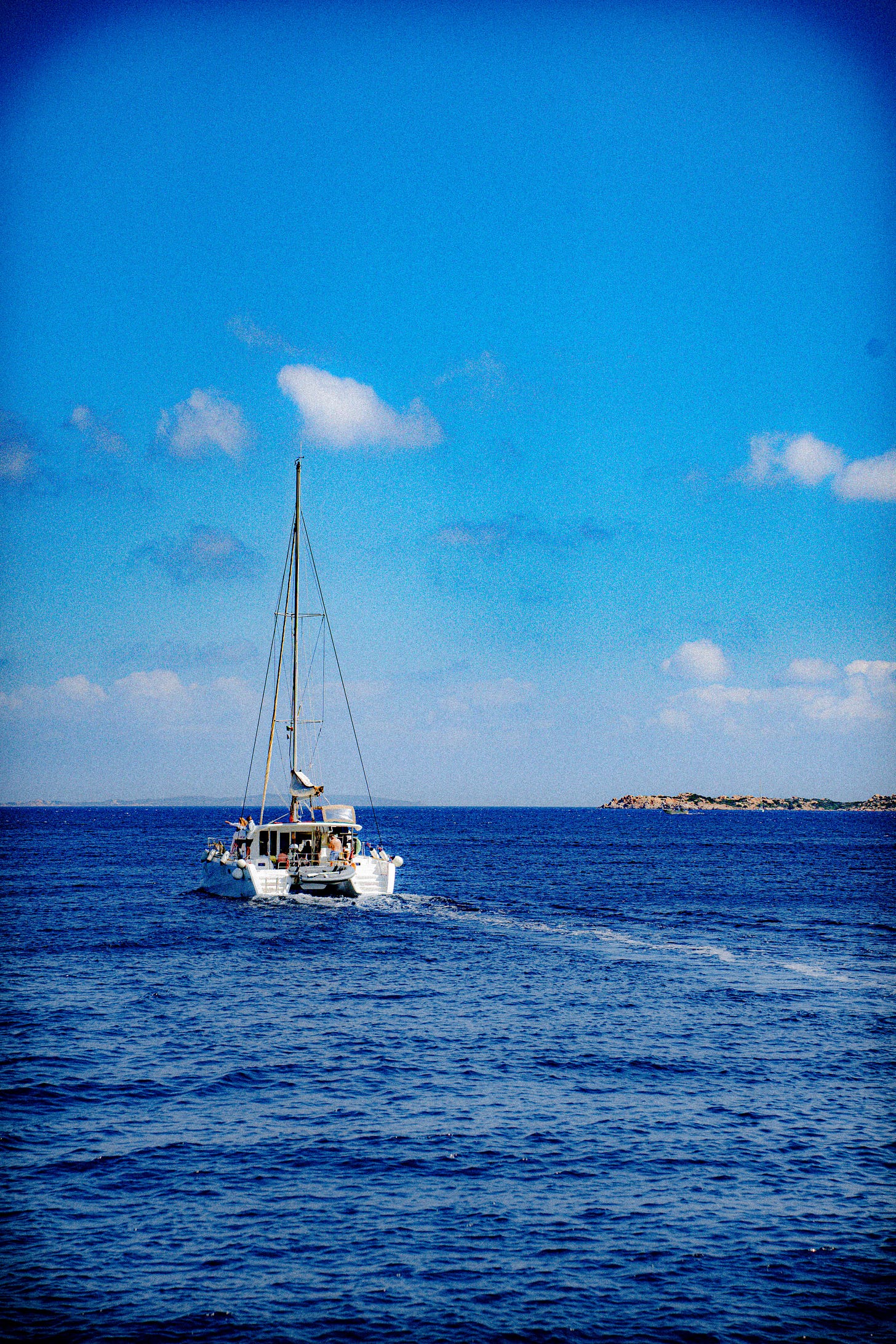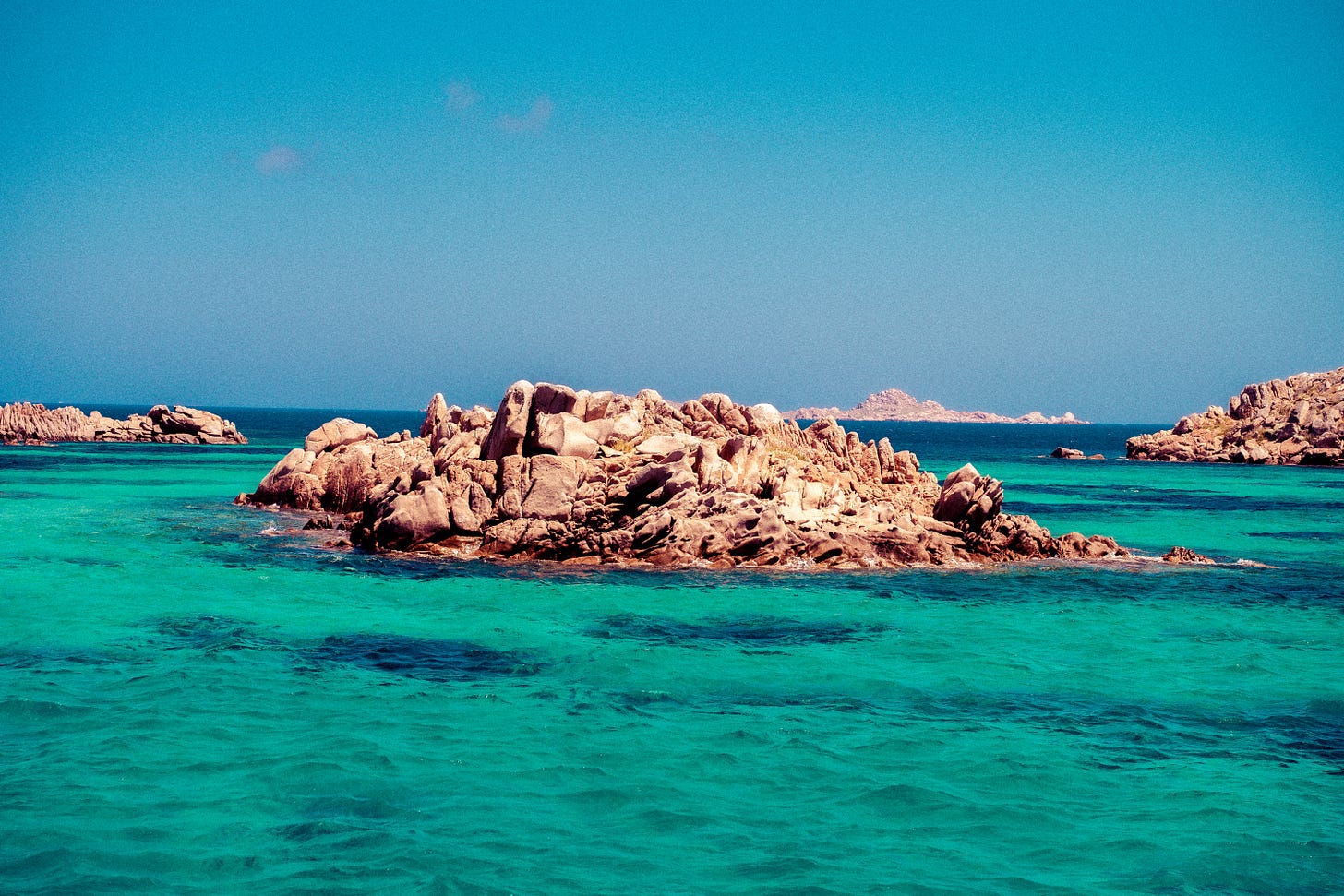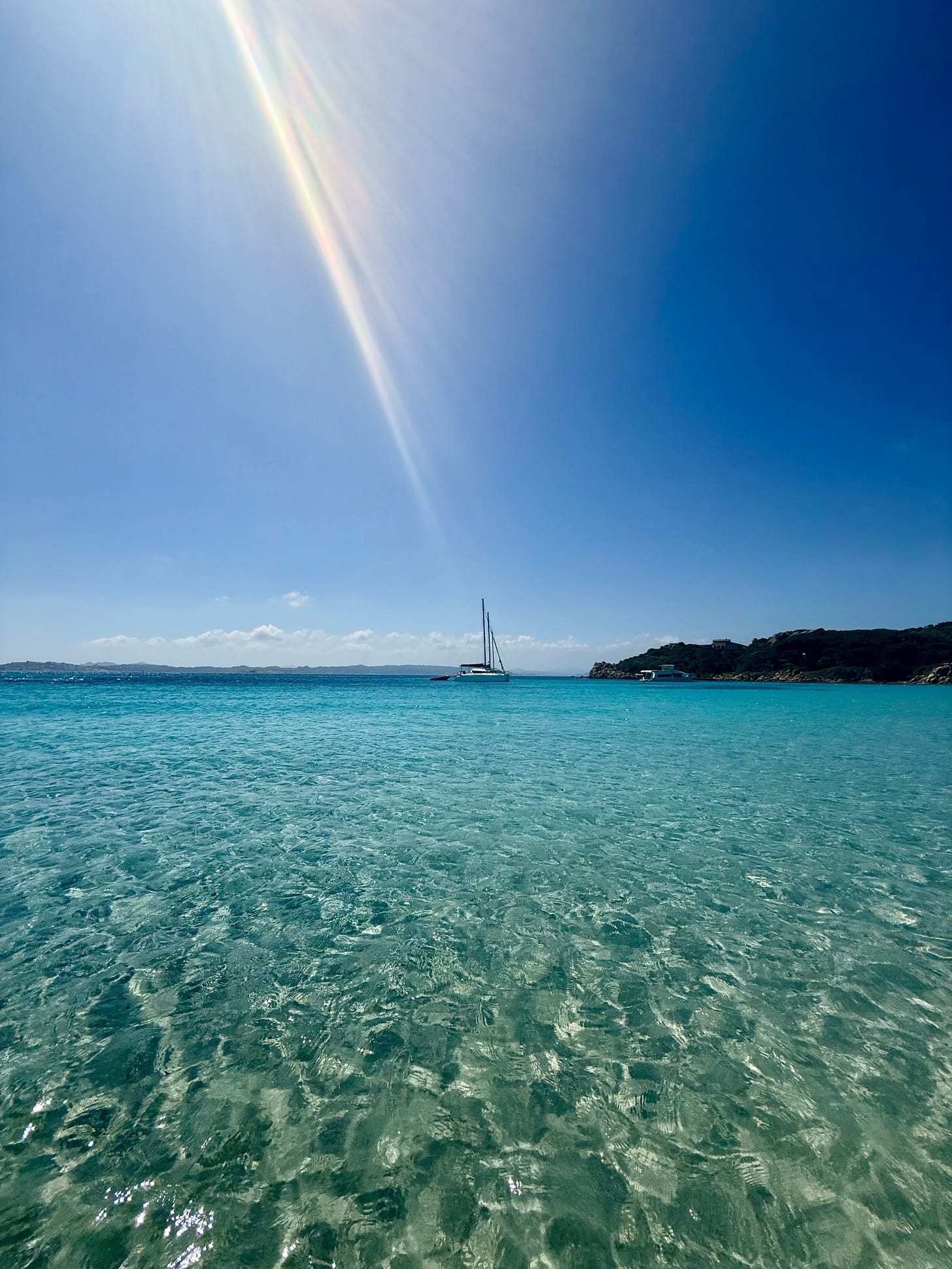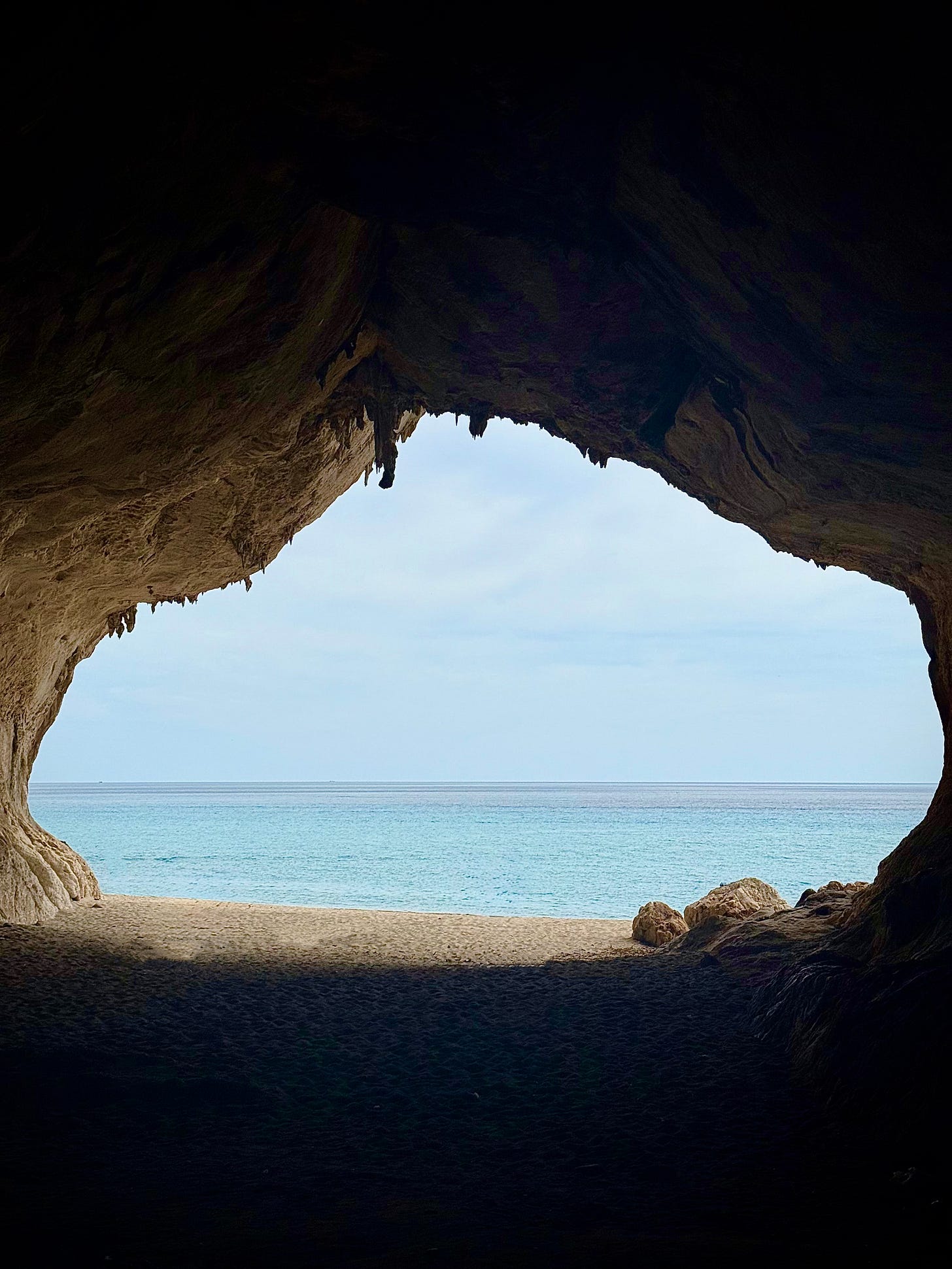Sardegna is an island of ancient magic
"Un'isola indimenticabile di antica magia." Aquamarine waters, dramatic beaches, rugged mountains, and lush forests abound.
Chapter 1: Saltwater & Tranquility
We call it Sardinia, but to the local people it is known as Sardegna.
Authentically Sardinian things are described as “sardo” and even the language itself is called Sardu.
And yet here, there are many different dialects even on this moderately sized island, second largest in the Mediterranean only behind Sicily.
When we stayed in the capital Cagliari (South Coast), our host Viola, a native to this island, told us that if she were to drive an hour north into the interior you would find shepherds who spoke their own version of Sardu, and that for her, it would be impossible to understand. In that moment I visualized how throughout the world there are proud people; those who’ve never left where they’re from; who withstood invasions, colonizations, and relative isolation to preserve their own rare richness of speech. Even the acqua of the ocean which surrounds us is just as unique and diverse.
When I first dove into the waters of Spiaggi Mari Ermi (Western Sardgena) I instantly noticed how incredibly salty it was. So salty, I kept licking my lips when I emerged from beneath the crystal blue. It truly tasted delicious. My hair felt heavenly and my skin radiated with crystals that evaporated into the Sardo sun. The water was an elixir, so cold and precious despite baking in the light.
As I dove underneath for another round it filtered through my nostrils and my teeth and my pores and I felt an equalization throughout my entire bodily system - the bad filtering out into the great blue yonder and the salty goodness entering by osmosis.
Maybe some of you know Sardegna to be a “blue zone.” But… did you know it was the first ever blue zone identified more than 20 years ago? A place where people live tremendously long and happy lives until they’re 100 or more; where people eat healthy food they grow locally; where people have strong family connections; where people “live slow.” The blueness of the zone has nothing to do with the many colors of the ocean here – it connects to blue circles that the National Geographic fellows used to first identify these zones back in the day on a physical map! However, in my opinion, let’s add to the list: this is a place where people get to swim in a special kind of water that charges you up like a human renewable battery.
*Author’s Note
We arrived on a Sunday to Cagliari. Overtaken by the calm as we drove through the streets.
Easy-breezy feeling of a seaside town so close to water, even when you can’t see it…
The town was washed in a hushed kind of serenity.
Visually, Cagliari was not breathtaking, serving its function more as the capital. Taller buildings than you’ll find anywhere else on the island. But the vibe in the air was different. The frequency.
You could tell you were very much on an island.
And being on an island is a truly wonderful state of mind.
Chapter 2: The Charm of Bosa
Location: West Coast
On the day of my father’s 80th birthday, we left Cagliari in search of a white sand beach known as Spiaggi Mari Ermi. My goal was to find an uninhabited stretch of beach for him to relax and “catch rays,” as he’s very fond of saying.
Even though my father is distinctly American, he is unquestionably Italian. His deeply tan skin produces a bountiful, natural oil; his hairy arms & hairy hands, which were once used for tackling and stiff-arming opponents in American football most certainly could have been used for farming or masonry in the old world; he possesses an innate ability to speak with love and passion; he pursues sunshine; and he has an affinity for sitting on park benches or beneath shaded trees, always reminding me of his dear mother’s old adage: “I wonder what the poor people are doing?”1
The final road to Mari Ermi was flanked by golden flowers, and the water of the ocean was clearer than glass. We laid for an hour and strolled through the gentle ebb and flow of waves upon the shore that resembled more of a lake than the ocean.
I stood for a long moment where the sea meets the sand. That point where your feet descend into a quicksand and your ankles become one with the earth. You slip into a transcendental state when your gaze matches the line of the horizon and the rhythm of the lapping ocean becomes synonymous with that of your beating heart.
The sun at midday was intense though, and Pops offered the idea that we move along and be grateful for the sun we got, mindful not to overdo it.
So we headed off to Bosa. Our next stop for the night would supposedly be even more peaceful. A town known for its kaleidoscope of colorful houses painted every shade you could imagine. Even Viola when I mentioned the name “Bosa” swooned and rolled her eyes as if recalling a past lover. “What a lovely place,” she sang.
Indeed when we arrived, hooking around a low mountain along the coast, the town opened up into view before us. All of the buildings were stacked atop each other in a relaxed cornucopia of various pastels that were not only pleasing to the eye but comforting to the soul. There was even a big white ferris wheel in the center of the city as if the carnival was coming soon.
Bosa was a town I wish I could have stayed in longer. It was the first occasion on our trip that I promised I would return to one day — to spend more time and to understand its ways.
There were many flowers in Bosa, equally as colorful as the buildings. A single river ran from the nearby mountain and down beneath the stone bridge to the sea. Our host Guiseppe was born in Bosa and emigrated to Germany, only to return to Bosa to raise his family. He was a happy gentleman, the type you of person you hope to meet again and again, if God wills it.
Our room was small and the streets were steep but you began to understand why Italians lived so long in a place like this.
In the kitchen, a single picture stood in a simple frame on the counter. Guiseppe lovingly picked it up and held it closer for us to admire. These are precisely the kinds of moments that get me excited and make me feel the inherent value of life. I asked if I could take a picture, and my request filled Guiseppe with pride. He sensed in my interest that I was not just another guest or passerby, but a friend.2
We sat at the kitchen table where we were supposed to go over our documents, but found ourselves still marveling at the picture in Guiseppe’s hand. “You want to know something?” he said. He smiled, and so did we. “They used to call my father Cacciavite.”
Our blank faces and lack of reaction reminded Guiseppe that we weren’t fluent in Italian. “It means the ‘screw driver!’ My father was very tall and skinny.” Suddenly we were laughing together like old pals and the air felt easy.
I looked into the eyes of the boys in the picture again and marveled at the photograph’s silent power. The time, fashion, transportation, and attitude… In that picture they were boys, but their faces were already those of men.
Per Guiseppe’s recommendation, we parked near a small castle at the highest point of the city and walked a few blocks down to his house. He warned us in a text message that if we drove through the streets we would “damage the car.”
Animals lovingly lounged outside the entrances of their owners apartments, terracotta pots soaked in the sun, and fresh laundry waved in the breeze above our heads.
Bosa was beautiful without saying a word.
Pops was tired when Guiseppe left us.
He sat on the bed to test its firmness. “I think I’m gonna rest my eyes, Joe.”3
“Ok, I’m gonna see where the grocery store is and get some stuff for tomorrow,” I said.
“Sounds good. Make sure you get sugar for the coffee.”
“Got it.”
“And butter for the pan when we make the eggs.”
“Definitely.”
I climbed the staircase to the upper terrace to get one last look of the town.
From the roof, Guiseppe had pointed out in to the distance to the stone bridge we initially drove across, and he said, “Do you see that long white building with five windows?” As a matter of fact, I did. And just when I spotted it an old lady emerged from pneumatic doors with shopping bags in her hand.
“That’s the supermarket,” I said.
Guiseppe nodded.
“Just take the bridge and you’ll be there.”
Now from the roof again I coordinated my body to hone in on the bridge so I wouldn’t have to look at the map on my phone. My intuition told me that the labyrinth of staircases and cobblestone streets outside Guiseppe’s door might confuse a person on their first time around. But from this bird’s eye view, I took a snapshot in my mind and in doing so, I absorbed the panorama of Bosa itself.
Grocery List:
Bread
Butter
Prosciutto
Mozzarella
Olive Oil (Extra Virgin)
Balsamic Vinegar (Modena)
Sugar (for the coffee)
Water (for the road)
It felt so good to leave the house in search of the grocery store.
Going to restaurants is fine and good. Going to the grocery store when you first settle into a place that you’re staying at for a few days, even if just one day, is honestly a really fun adventure in a foreign country. It makes you feel like you’re included in the nucleus of what’s going on in that city, like you’re actually contributing to society.
Based on my hair, my beard, my clothes, my walk with a purpose, the people I passed by assumed I was local. This is always my goal. To adapt and become one with a place.
I came upon the bridge and realized: this is the only way to cross the river for a mile in either direction… You have to walk as close as you can to the side so cars can drive past without splattering you.
Meanwhile, that same little old lady I saw from the roof was just now coming over the bridge, completely unfazed, in the middle of her daily routine. So I followed suit, kept my head down and put one foot in front of the other across the stoney bridge of Bosa.
Once I was in the store, I gathered all the supplies from the list and I even found a 4-pack of coca-cola in glass battles. Those and a carton of double-chocolate cookies found their way into my cart :^)
But I made one fatal error… the tomato.
The cashier picked it up after she scanned everything else and said something completely incomprehensible in Italian.
“Mi dispiace, parlo Inglese,” I replied.
Her face lightened up. “You have to weigh it yourself,” she said, and put the tomato in my hand.
I looked at the man behind me now, patiently waiting for me to go correct my error.
I quickly stepped out of line and found one of those produce bags that are totally impossible to open and I slid the tomato in, then I put it on the machine that had a scale attached to it.
A digital keypad appeared in the middle of the screen with the weight displayed at the top, and an “ENTER” / “CANCEL” button at the bottom…
My face sank into instant confusion. The man stepped over to me.
First, he gently pointed to the sign above the tomatoes - “Pomodoro Rossi (179)”
Then he gently lifted my tomato off the scale to reset the machine. When it set to 0, he gently placed the tomato back on the scale and the digital keypad reappeared onscreen.
He punched in 1-7-9, and the machine magically spit out a sticker with the appropriate price relative to the tomato’s weight.
I smiled humbly and stuck the sticker to the bottom of my bag. The man patted me on the shoulder. “Bravo,” he said.
The woman laughed at us both but her eyes were kind.
I thanked the man one more time and even reached out to shake his hand. His grip was firm from fishing ropes or laying bricks, and his smile, which finally appeared, was missing many teeth. Shocking and sincere, this would be an episode I never forget.
On The Way to Palau - Interlude
When we left Bosa in the morning it was misty.
I looked out to the river flowing to the sea.
A gentle sadness called out to me from the land not to leave so soon, but it also understood why we must be on our way.
The next stop was Palau, a port only a handful of hours away.
Today was more about driving than anything else.
We’d need to set up shop so the following day we could rise early enough to catch a boat and explore the historic archipelago of La Maddalena.
The magical waters of La Costa Smeralda were waiting.
The heavy mist turned into rain as we entered Alghero, a town many people mentioned to us, but frankly was unimpressive. It seemed like half the city was under construction and the falling rain signaled us to just move on.
Spiaggi La Pelosa
Location: Northwest Corner
At the northwest edge of the island, we found ourselves a dreamlike outcropping that was a relic of a time long gone. An outpost for defense against pirate ships and invaders, now a playground for seagulls who dared each other to flying competitions.
They wanted us to pay €3 per person just to step on the beach. I laughed out loud.
Down the sidewalk, I spotted a small restaurant. Sure enough, around the corner of the eatery there was a little pathway that deposited you to a perfect collection of rocks and I managed to snap these shots, crouched right above the water on the jetty.
Castelsardo
Location: North Central Coast
After La Pelosa we were finally headed due east. Soon we stumbled upon a castle town.
In the center of the “city,” we parked on a side street & slowly strolled into the plaza.
The panoramic view opened into the Sardinian interior. But more so, what caught my eye was an inspiring and fascinating sculpture.
Chapter 3: Set Sail! La Maddalena Archipelago
Location: Northeast Corner (offshore)
Morning in Palau.
We found a café for a nice coffee and cornetto (that’s a croissant), our usual light fare to get the wheels turning.
Then we we drifted down to the dock to locate the ticket office.
Turns out, you just spitball with whoever’s out there to see their price and find out which islands they’re going to based on the weather conditions.
Our boat would be the Jasmine. Sturdy. Crimson color in color. Various flags waving from its mast.
Today would be a windy voyage, the barefooted, joint-smoking boat captain of the neighboring vessel shouted out, good music drifting from his JBL.
I prepared myself for what lie ahead and studied the flags as the wind mounted higher, with the Sardinian flag being the most prominent.
What started off as your average everyday dark blue ocean water eventually transformed into pockets of translucent mint greens, scintillating cyans, and tantalizing teals. The air was fresh as can be.
The Jasmine took us out to various spots to simply admire from the boat, but when we finally landed on Isola Santa Maria, the water was truly impeccable.
Everyone was giddy with delight.
People danced as they got off the boat and hurried to find a spot.
Both those old and young stripped their clothes and threw them into the hot sand.
With only 1 hour before departure to the next island, we soaked it all in and marveled at the beauty of this particular spot on Earth.
Back on the Jasmine - a pasta lunch in tomato sauce with mussels and shrimp.
The captain threw the leftover pasta into the sea and a thousand fish flocked into a feeding frenzy. The captain laughed a sailor’s laugh and he threw more pasta into the sea so the girls could take their videos for Instagram.
The water was so clear, you could spot each fish swimming and wiggling with an incredible kind of energy.
At the end of the day, when we finally got back on land, Pops was walking sideways. Boy was he glad to be back.
I’ll admit, there were times when the wind was too much.
You’d cross a channel through the open ocean and get hit with such a force that it snatched your breath away and sealed your eyelids shut. The boat would surge through a chop in a wave and the splashing foam would climb and clap its way onto your skin, sending a shiver through your spine.
But that’s part and parcel of seafaring.
Personally, being on the water brought me freedom and joy and made me wonder about learning to sail for real. Having your own sail boat where you could literally go anywhere in the world? Not an easy job, but completely achievable. With time, like most anything.
If you can believe it, after the boat we jumped in the car and drove 100 more miles down to Cala Gonone. The following day we’d catch another boat, this time going to one single, magnificent beach, rather than a whole expedition of an archipelago.
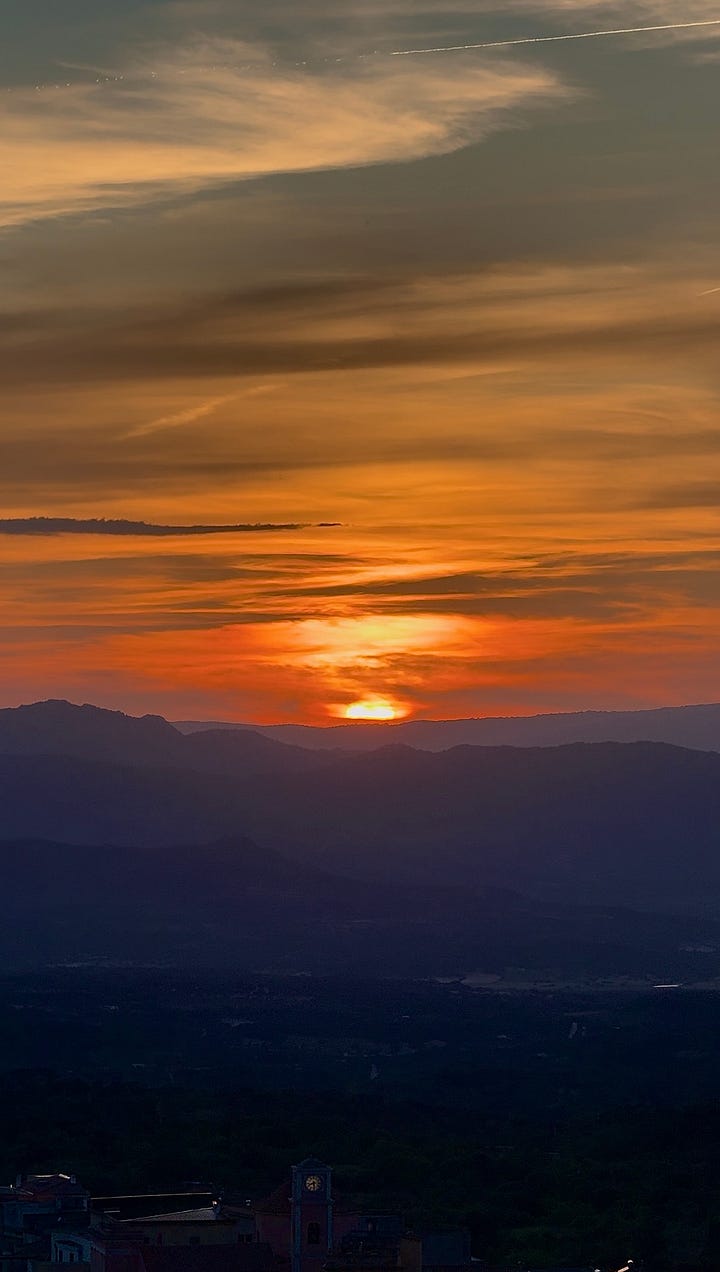
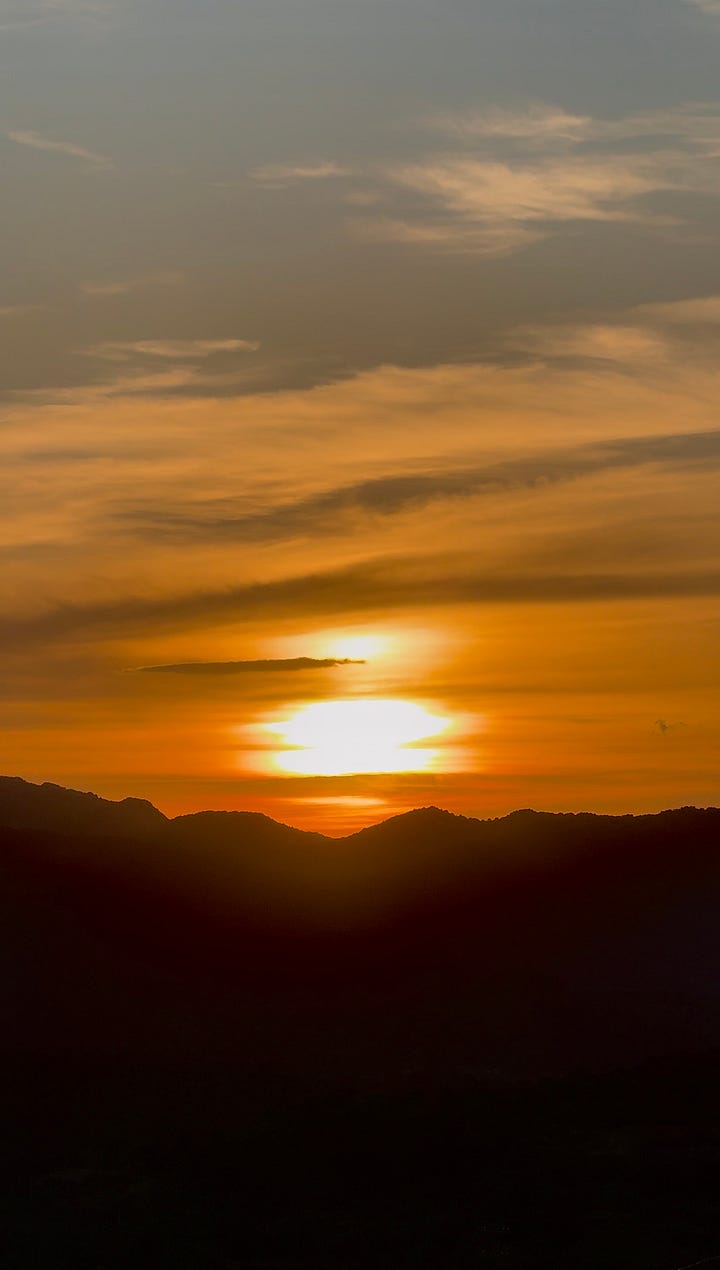
The sunset in the hills of Dorgali was the final checkpoint. The sun was massive and ablaze as church bells rang out Eight.
Teenage girls drove up the mountain in teeny cars and parked nearby, emerging in packs to giggle and smoke cigarettes.
A forest of pines overhead growing diagonally out of the side of the mountain created a beautiful fragrance that mixed well with the European tobacco.
Evidently, we’d stumbled on a prime location.
Down the backside of Dorgali we’d be in Cala Gonone and asleep at the end of only our fourth day in Sardegna…
Roughly 400 miles driven on land so far. Geographically, if you imagine the face of a clock — traveling counterclockwise from the 6 o’clock position in Cagliari (South) to the 1 o’clock position in Palau (Northeast).
As I inhaled fresh pines and the final bell of the church faded, I realized just how much I was enjoying Sardegna, but felt in all honesty, like we were moving too fast.
Chapter 4: The Swallows of Cala Luna
Location: East Coast
Cala Gonone was our last town — one with infinite charm. All roads led to the port. Gravity did the work. When you stepped out the door, you were pedaling down the streets to the sea. Teams of boats waiting to take you to the main attraction. Tourists from various European countries all waiting for departure, speaking in hushed tones so as not to be discovered, even though fedoras and sunscreen on their noses never fail to reveal they may be from out of town.
Word of mouth said the beach at Cala Goloritzé was “best.” If you do your research, you’ll find it’s truly otherworldly. And rightfully so, shaped and preserved by nature, which means your options to get there are:
Another long and expensive boat ride or…
Drive further down the coast, park on the interior, and hike 90 minutes (one way) at an intermediate level…
Alternatively, you can go to Cala Luna.
An incredibly scenic stretch of beach with massive natural caves and a secret hike to a gnarly viewpoint — all conveniently located at the first stop off the boat only 10 minutes from Cala Gonone.
The first thing I noticed once we ran ashore were tiny birds zooming through the air.
Playful creatures that traveled in 2’s or 4’s, weaving in and out like drivers in a Formula 1 race. The caverns and rock formations their endless track.
Swift movements and visibly split tails were remarkably hypnotizing.
Their cheerful chirping bounced to me on breezes unseen.
They were having so much fun and nobody seemed to care or pay attention. Except, when I pointed them out to Pops, he had already spotted them for himself, and together we took great delight in watching them soar in the sky.4
I worked my way down the beach and marched 50 yards into the biggest cave I could find. Swallows would dive in and out and probably knew these places long before we’d ever been there.
Inside the cave, in the way way back, the sand under my feet was incredibly cool.
But the caves got boring pretty quick. I decided to press on, as I usually do, to the very edge of the beach just to see what’s out there.
What I found was a secret stone staircase carved into the cliffside that was calling for someone to climb it, but growing bushes and tree branches made it seem like the way wasn’t open.
I moved the branches aside and began to climb.
The footpath disappeared and suddenly it was just me and ancient stones, colossal boulders that didn’t care if I lived or died.
Conditions became precarious, but I could see there was a landing up above, I just needed to “scramble” and trust the cord looped around my wrist attached to my camera would hold tight and not snap in this exact moment that I needed it most so I could move on all fours.
I squeezed and clawed and pulled myself to the top, stood firmly, and centered myself.
I marveled at the open ocean, the sheer face of the cliff, and the way the terrain fell into the water or rose up from it… whichever way you want to look at it.
Along this journey, I am finding my voice, both in the written word and the photographic frame. Editing is always experimentation so I’ve given myself freedom to discover what sticks.
Always, when I go great heights or push the limits to find a picture, I find myself in isolation. I think about Pops and I hope he’s ok. I feel quite deeply and simultaneously the call to experience what’s out there, but also the love and duty to be by his side, to simply be present with him.
So far on this Italian odyssey, just like our life together, it’s been a mixture of both.





